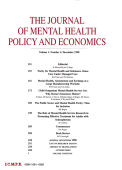Background: Historically, U.S. health insurance plans included fewer and more
restrictive benefits for mental health (MH) and substance use disorder (SUD)
treatment compared to general medical care. The 2008 Mental Health Parity and
Addiction Equity Act (MHPAEA) mandated that group-based private health plans
covering MH/SUD treatment do so in a way no more restrictive than coverage for
general medical care. Multiple rounds of rulemaking, including 2024 final rules
most recently, have strengthened federal regulation of plans’ non-quantitative
treatment limits (NQTLs).
Aims of the Study: To investigate how SUD treatment rates,
perceived unmet needs, and barriers to treatment changed for adults with
group-based private insurance following MHPAEA.
Methods: We conducted a secondary analysis of annual, cross-sectional data
from the National Survey on Drug Use and Health (2006-2014) with a sample of
adults aged 18-64 years meeting criteria for SUD treatment need. We used
difference-in-differences models to estimate and compare outcomes between
adults with group-based private insurance (GBPI) and multiple comparison groups
including those with individual-based private insurance (IBPI) before
(2006-2009) and after (2011-2014) MHPAEA implementation.
Results: Among 32,605 survey respondents with SUD (weighted N=16,108,465),
17,065 individuals had GBPI. For this group, adjusted rates of any past-year
SUD treatment remained low, and we did not detect a statistically significant
change following MHPAEA implementation (6.4% pre-parity vs. 7.0% post-parity;
+0.5 percentage points, 95% CI: -1.1 to 2.2,
p=0.514). Difference-in-differences analysis showed no significant difference
in changes between those with GBPI and those with IBPI (+3.1 percentage points,
95% CI: -3.8 to 10.0, p=0.380). Self-identified unmet SUD treatment need also
remained consistently low (3.9% pre-parity vs. 3.9% post-parity; +0.1
percentage points, 95% CI: -1.0 to 1.1, p=0.895). Among GBPI enrollees
reporting unmet need, no significant changes were observed in barriers related
to cost (14.9% post-MHPAEA), treatment accessibility (22.8%), ambivalence about
seeking treatment (66.8%), or stigma (19.1%). Only half of GBPI enrollees knew
their insurance covered SUD treatment, with nearly 40% reporting they didn’t
know.
Discussion: These findings align with other studies of U.S. parity laws,
which have found little to no impact on SUD treatment rates despite potential
improvements in financial protection. Limitations include reliance on
self-reported data, inability to identify specific insurance plans exempt from
MHPAEA, and lack of state-level identifiers to account for pre-existing state
parity laws.
Implications for Health Care Provision and Use: Providers
and health systems may consider new strategies to identify SUD treatment needs
and improve awareness of insurance coverage among patients, as nearly four in
10 individuals with group-based private insurance and SUD were unaware of their
SUD coverage.
Implications for Health Policies: While recent MHPAEA
final rules strengthened enforcement mechanisms and prohibit restrictive NQTLs,
our findings suggest additional policies may be needed to improve access to SUD
treatment, including efforts to increase awareness of treatment need and coverage,
reduce stigma, and enhance treatment availability.
Implications for Further Research: Future research could
examine how the 2024 MHPAEA final rules affect NQTLs and investigate the
combined effects of MHPAEA with other health reforms on SUD treatment access and strategies to overcome persistent non-financial
barriers to treatment. |
